Are iceboxes all they’re cut out to be? To find out, we kicked them out of the ute and them through their paces.
We’re simple men with simple needs. There are fish in the ocean, we catch the fish. Warm fish makes us crook, we keep the fish cold. It’s a system that’s worked for hundreds of years now. Who are we to turn our noses up at convention? For this reason the icebox cooler is an integral part of any camping trip or offshore fishing run. With the right cooler, one bag of ice can get you home free. But what makes a cool cooler? We had no idea, so we decided to find out.
Over the next few pages you’ll find rundowns on some of the most popular coolers on the market — from budget offerings through to the best money can buy. We’ve loaded them up and put them to the test. If you’ve ever wanted to know what difference a good icebox can make look no further.
TO THE TEST: ICE RETENTION
Coolers by their very definition need to, well, cool. But there’s more to it than having the stuff inside slightly colder than the stuff outside. While we were tempted to load each cooler to the brim with fresh barra and see how long it took to smell out the back shed, we figured we’d do things a little more scientifically. We reached out to the local health inspectors, got the lowdown on safe food temperatures and even borrowed one of their calibrated infrared food thermometers.
From here the test was relatively straightforward. Each cooler was positioned out of direct sunlight and, once equalised, was loaded with 10kg of ice cubes. A single beer was placed in the middle before the cooler was sealed tight. Every 24 hours, they were popped open, lasered and put back in the dark. By using the same amount of ice and as few items as possible we kept our variables to a minimum to work out what these bad boys can really do. Once the beer topped five degrees centigrade, it was game over.
TORTURE TEST
Short of wear and tear, the most likely damage your cooler is likely to receive is from falling. To simulate a cooler falling out of a moving vehicle, we, er, pushed them out of a moving vehicle. The chariot of cooler death was driven on the same route, at the same speed, while each cooler was slid out the open tailgate once the speedo tapped 60km/h.
The cartwheeling cooler tested latch strength, hinge strength, side wall cracking potential and general wear and tear. If you’re putting your handles under more load than a 60km/h crash, you might need to rethink your sausage sizzle requirements.
6TH PLACE
Evakool Fibreglass Icebox 60l
Fibreglass? That’s a bold strategy, let’s see if it pays off
Fibreglass iceboxes were once the big swinging mackerel in the cooler market, but with the introduction of rotomolded offerings they’ve fallen by the wayside. Aussie-based Evakool reckon they’re still worth their salt.
The Icebox 60L is one of the simplest offerings on the market, but still commands a hefty price tag. At $439, it’s bang in the middle of the field.
Unfortunately, on the features front it’s rather light-on. The high-gloss surfaces mean minimal scrubbing required if you forget to clean it for a week or two, but the drain plug is raised above the floor surface, so you’ll have to do some jiggling to get the bleach-water-fish-guts soup out (all other offerings have a sump for easy draining). Fortunately the drain plug is captive, so you won’t lose it. The handles and hinges both project outside the body presenting an awkward packing shape and making them vulnerable to damage.
On the cooling front, the Evakool does perform. It’s the cheapest offering to make it to the six-day mark with a respectable 2.6 degrees internal temperature.
Throw it on the road at 60km/h and the drawbacks of fibreglass construction become apparent. While the handles and hinges held up better than expected, the capping joining the inner and outer glass layers shattered, exposing the insulation. The lid corners also cracked, but it’ll live to fight another day.
5TH PLACE
ESKY Arctic Pro Rugged 70L
Can Australia’s old faithful run with the big dogs?
Australia’s favourite, the Esky has been a part of our culture for nearly 70 years. They’ve been lugged to every campsite and fishing spot in the country and are so popular their brand name has become the de facto moniker for every icebox.
The Arctic Pro Rugged is one of the top-spec models from Esky, and it shows in the design and features. The top of the Esky is fitted with a cushioned pillow, making it a viable seat, not just a plastic box. The handles are recessed into the body so they don’t interfere with stowing procedures, and the corners are reinforced to protect against bumps and drops. There’s a clever auto light inside and a tab for locking up the catch on the front.
Unfortunately, things fell apart for the Esky when it came to ice retention. After 24 hours, it was a degree and a half warmer than the frontrunners, jumping from 2.5 degrees internal temperature on the fifth day to a huge 9.7 degrees on day six. Its low cost meant it was a standout in material selection, but not in a good way.
The plus side of the lightweight construction is the 8.4kg total weight meant it fared reasonably well in the torture test, coming through with little more than a dented corner and a few scuffs.
Rocking up to the boat ramp with an Esky in tow won’t have other blokes looking at your setup starry-eyed, but if you’re after a basic cooler to get your catch home, it’s a safe option.
=3RD PLACE
Techni Ice Signature Series Icebox 70L
The cheapest rotomolded cooler on the market might just be the toughest
The next step up in the price range is the Techni Ice Signature Series Icebox. At $399, it’s $120 more than the Esky offering, but steps up into a whole different construction method.
Where the cheaper Esky is a simple Polyethylene box (less than 1mm walls), the Techni Ice features rotomolded construction. The denser plastic and thicker overall walls give the cooler a sturdier build that should translate directly into cooler food for longer.
There are plenty of clever designs in the Techni Ice offering. From the rope handles with a recess in the body for optimal packing, through to the huge 50mm drain hole for quick pack-up. Inside, a wire tray keeps food out of the slush while the integrated hinge should see it hold up well in the torture test. Despite the huge 74mm thick walls, it only punches in at 14kg, and with tie-down points and secondary integrated handles, it’s definitely a practical offering.
Even with all this, the Techni Ice offering fell over when it came to ice retention. After 24 hours the cooler was already the warmest of the lot. From this point, it maintained a safe temperature for five days before cresting up to 6.5 degrees on day six.
Time to kick it off a ute. This is where the rotomolded construction came into its own. Despite cartwheeling down a gravel road at 60km/h, the Techni Ice cooler came out almost unscathed. A few scuffs on the corners proved the Rotomolded design is tough enough for whatever you throw its way.
=3RD PLACE
Pelican 70QT Elite Cooler
Like the space cases, only colder
Jumping up into the rocket ship category is the Pelican 70QT Elite Cooler. Pelican are best known for making storage cases, so it’s no surprise they’ve made one you can stuff full of ice and slap a fish in.
From the top down, it’s clear Pelican have taken the design seriously. There are integrated fish scales in metric and imperial, as well as four cup holders — all with drains so they won’t fill up with beer. There’s a padlock hole so your booty won’t be plundered and it’s even reinforced with stainless steel plates. The robust construction earns it a certification as bearresistant. While the drain hole is small, it is in a sump, so will completely drain the cooler. The handles are integrated into the design so are robust, but stick ridiculously far out making it a pain in the ass to load, although at 15kg, it’s at least easy to throw around.
Despite all the thought that went into the features, Pelican forgot to design a good seal, and the results show in ice retention. Despite hovering around the zero and one degree mark for the first five days, it jumped dangerously high at 3.4 degrees on the sixth day, before completely falling apart at 12.5 degrees the next. Temperatures would hold steadier with more ice/items inside, but the same could be said for any cooler.
However, that strong construction held up in the torture test. Despite pogoing down the road like a pharmaceutical enthusiast, it pulled up relatively unscathed. The protected hinge and clasps were damage-free, with nothing more than a few scuffs to corroborate its war stories.
2ND PLACE
Yeti Tundra 65
Instagram hype or serious kit?
If you haven’t come across the Yeti brand yet, chances are you don’t have Instagram. They’re the Apple of the outdoors world — simple, clean, expensive. The Tundra 65 is the first cooler to crack the $500 mark, so better come out of the gates swinging if it wants to be taken seriously.
At first glance, it’s a rather simple unit. Rotomolded construction makes it robust and lightweight — the second-lightest at a hair over 13kg. Its simple design also picks it up Bear Certified status. Part of that is the easy-to-use rubber pull handles, although in cold weather they could cause issues, especially with frozen fingers. The cooler is padlock-compatible on each front corner, with tough rubber/rope handles tucking neatly into deep recesses for easy storage and carrying.
There’s no laser-guided fish scaler or automatic camp assistant, but the Yeti Tundra 65 did come into its own on the cooling front. At 24 hours in, it had the lowest temperature of -0.9 degrees, holding steady at 1.1 degrees a full week later before peaking at 7.8 on day eight.
On the torture test, the Tundra 65 held up OK — scuffed and scratched, but relatively unharmed except for the DIY camouflage paintjob it received sliding into the bush. It’s effectively unharmed, but you probably won’t see photos of it on Instagram anymore.
1ST PLACE
OtterBox Venture 65 Cooler
Does the big end of town still give value for money?
At $569.99 and just under 15kg, the OtterBox is undoubtedly the big end of town. But can its bite match its bark?
The most noticeable standout about the Venture 65 is its accessory mounting system. Four ridges run down the front and rear providing eight mounting options for various included and optional accessories — waterproof lockable boxes for phones and keys, drink holders, prep boards, bottle openers, food trays and even a fishing rod holder. Unfortunately, the integrated handles do stand proud, but less aggressively than the Pelican.
On the ice-retention front, the OtterBox was barely edged out by the Yeti, but not by a usable amount. It reached a low of -0.5 degrees before slowly climbing to 1.8 degrees on day seven then cresting at five degrees on day eight.
With the pretty photos done it was time for the tough test. Despite making our credit cards cringe with every bounce, the OtterBox came out better than expected, a testament to its rotomolded construction. It suffered only a few scrapes and gravel rash on its bottom.
We’re not here to decide your budget, but this is a pretty clear-cut case of you get what you pay for.
HOW TO GET THE MOST FROM YOUR COOLER…
Some (most) of these coolers boast the ability to keep ice for up to two weeks, while we maxxed out at seven days for food-safe temperatures. What gives? It comes down to thermal efficiency. Put simply, cold stuff likes staying cold. The more densely packed your cooler, the longer it’ll stay cold.
If you’re trying to get maximum life out of your ice, keep the cooler out of the sun to reduce heat transfer, have it packed to the brim with the coldest stuff you can fill it with and open it as little as possible. If you really need it to go the distance, refrigerate your food before putting it in the cooler and drop the cooler’s internal temperature overnight with a sacrificial bag of ice before loading it.

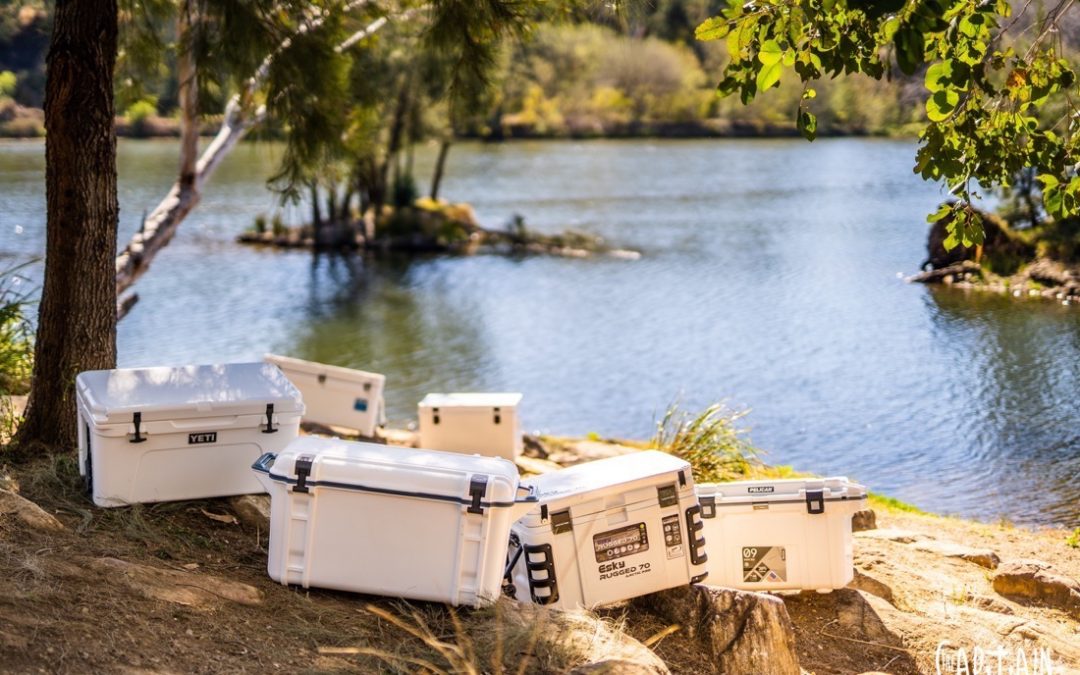
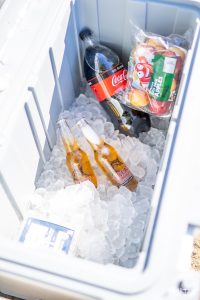

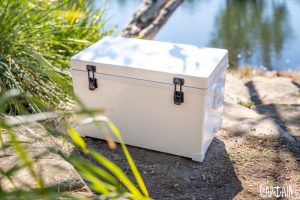

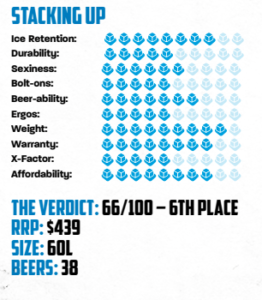
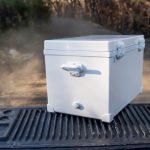


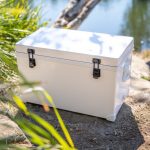
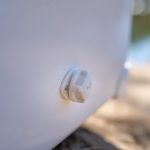
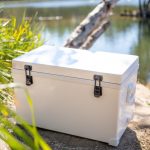
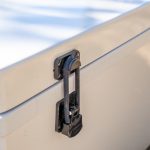
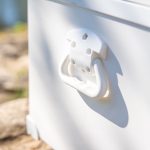


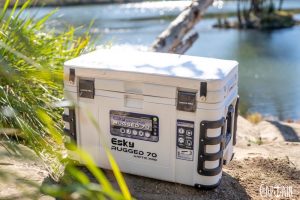
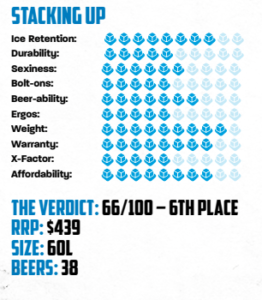

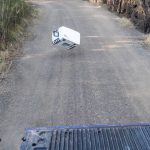
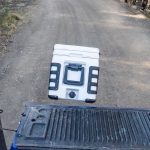
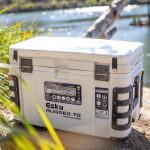

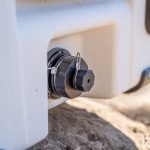
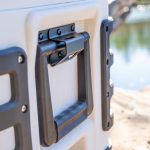
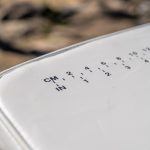
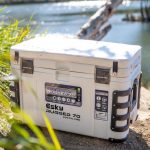
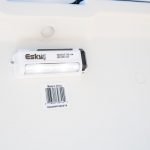

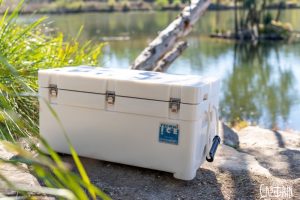
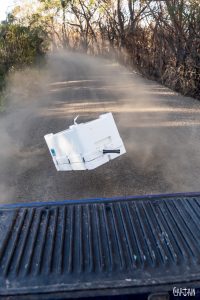
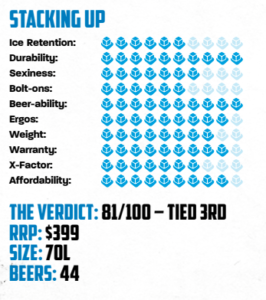
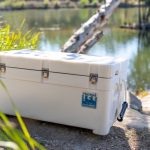
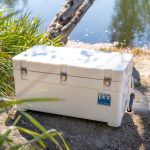
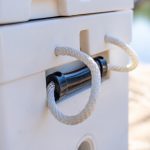
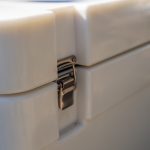

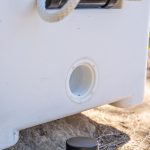
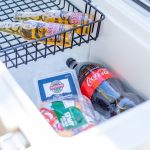

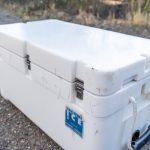
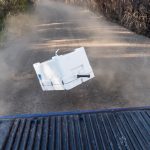
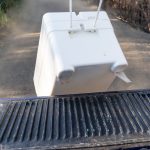
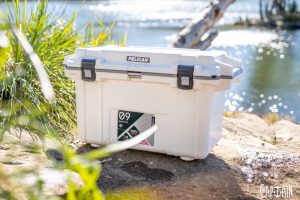
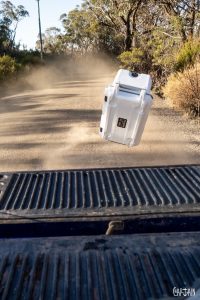
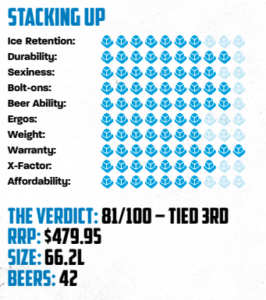
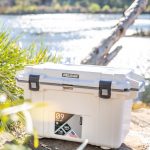
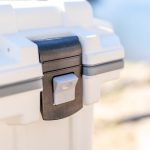
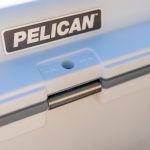
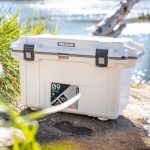

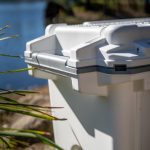
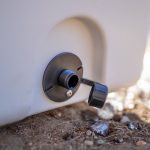
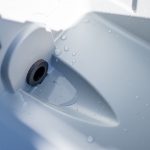



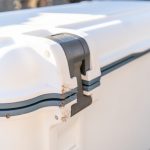
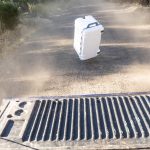
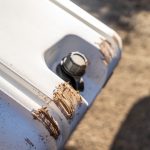
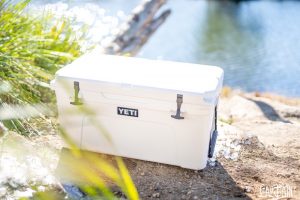
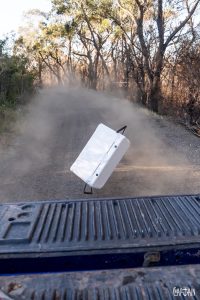
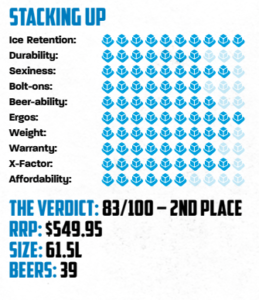
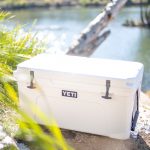
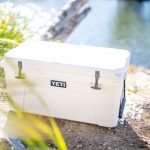
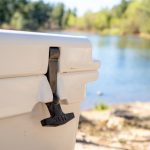
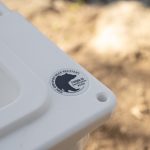
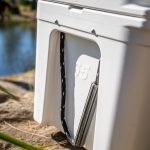
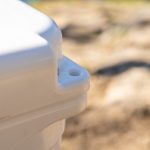
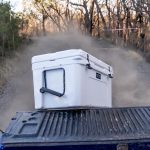
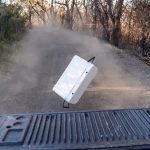

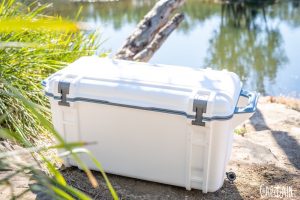
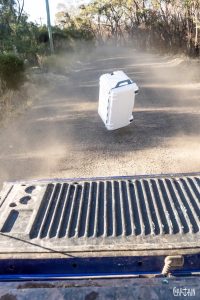
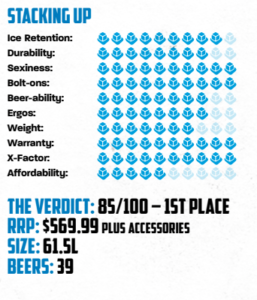
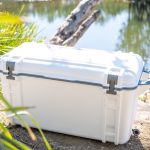
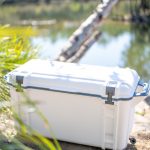

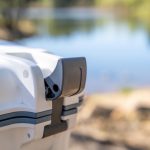
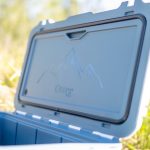

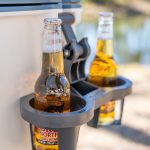
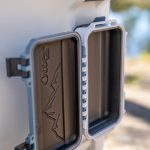

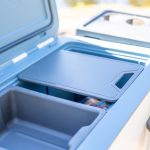
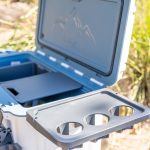
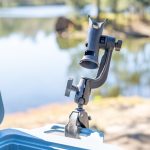
Recent Comments